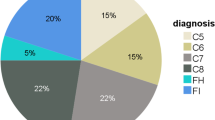Abstract
We evaluated the complement system in 29 children (mean age: 4.5 years) who survived fulminant meningococcal septic shock. No terminal complement deficiencies were found. One patient, who experienced the most dramatic disease course, had a decreased haemolytic activity in the haemolytis-in-gel test for the alternative pathway. The properdin concentration in serum of this patient was < 0.1 μg/ml (n = 17.1−27.7 μg/ml). Coagulation studies revealed a heterozygeous type I protein C deficiency as well. He was the only patient with aNeisseria meningitidis group Y infection.
Similar content being viewed by others
Abbreviations
- GMSPS :
-
Glasgow Meningococcal Septicaemia Prognostic Score
- MD :
-
meningococcal disease
- PC :
-
protein C
References
Andreoni J, Käyhty H, Densen P (1993) Vaccination and role of capsular polysaccharide antibody in prevention of recurrent meningococcal disease in late complement component deficient individuals. J Infect Dis 168:227–231
Beatty DW, Ryder CR, Heese HDV (1986) Complement abnormalities during an epidemic of group B meningococcal infection in children. Clin Exp Immunol 64:465–470
Ellison RT, Kohler PF, Curd JG, Judson FN, Reller LB (1983) Prevalence of congenital or acquired complement deficiency in patients with sporadiis meningococcal disease. N Engl J Med 16:913–916
Fearon DT, Austen F, Ruddy S (1974) Properdin factor D. J Exp Med 140:426–436
Figueroa JE, Densen P (1991) Infectious diseases associated with complement deficiencies. Clin Microbiol Rev 4:359–395
Fijen CAP, Kuijper EJ, Hannema AJ, Sjoholm AG, Putten JPM van (1989) Complement deficiencies in patients over ten years old with meningococcal disease due to uncommon serogroups. Lancet 373:585–588
Fijen CAP, Kuijper EJ, Tjia HG, Daha MR, Dankert J (1994) Complement deficiency predisposes for meningitis due to non-groupable meningococci and Neisseria related bacteria. Clin Inf Dis 18:780–784
Fijnvandraat K, Derkx HHF, Peters M, Bijlmer RPGM, Prins M, Sturk A, Deventer SJH van, Cate JW ten (1995) Coagulation activation and tissue necrosis in meningococcal septic shock: severely reduced protein C levels predict a high mortality. Thromb Haemost 73:15–20
Gelfand EW, Rao CP, Minta JO, Ham T, Purkall DB, Ruddy S (1987) Inherited deficiency of properdin and C2 in a patient with recurrent bacteremia. Am J Med 87:671–675
Hassig A, Borel JF, Amman P (1964) Essentiale hypokomplementamie. Pathol Microbiol 27:542–547
Havens PL, Garland JS, Brook MM, Dewitz BA, Stremski ES, Troshynski TJ (1989) Trends in mortality in children hospitalized with meningococcal infections, in 1957 to 1987. Pediatr Infect Dis 18:8–11
Holme ER, Vietch J, Johnston A (1989) Familial properdin deficiency associated with chronic discoid lupus erythematosus. Clin Exp Immunol 76: 76–86
Lehner PJ, Davies KA, Walport MJ, Cope AP, Würzner R, Orren A, Morgan BP, Cohen J (1992) Meningococcal septicaemia in a C6-deficient patient and effect of plasma transfusion on lipopolysaccaride release. Lancet 340:1379–1381
Merino J, Rodriguez-Valverde V, Lamelas JA, Riestra JL, Casanueva B (1983) Prevalence of deficits of complement components in patients with recurrent meningococcal infections. J Infect Dis 148:33
Møller Rasmussen J, Brandslund I, Teisner B, Isager H, Svehag SE, Maarup L, Willunsen L, Rønne-Rasmussen JO, Permins H, Andersen PL, Skovmann O, Sørensen H (1987) Screening for complement deficiencies in unselected patients with meningitis. Clin Exp Immunol 68:437–445
Nielsen HE, Koch C, Magnussen P, Lind I (1989) Complement deficiencies in selected groups of patients with meningococcal disease. Scand J Infect Dis 21:389–396
Nilsson UR, Nilsson B (1984) Simplified assays of hemolytic activity of the classical and alternative complement pathway. J Immunol Methods 72:49–59
Platonov AE, Beloborodov VB, Vershinina IV (1993) Meningococcal disease inpatients with late complement component deficiency: studies in the U.S.S.R. Medicine 72:374–392
Ross SC, Densen P (1984) Complement deficiency states and infection: epidemiology, pathogenesis and consequences of neisserial and other infections in an immune deficiency. Medicine 63:243–273
Schlesinger M, Nave Z, Levy Y, Slater PE, Fishelson Z (1990) Prevalence of hereditary properdin, C7 and C8 deficiencies in patients with meningococcal infections. Clin Exp Immunol 81:423–427
Sjöholm AG (1990) Inherited complement deficiency states: implications for immunity and immunological disease. Acta Pathol Microbiol Immunol Scand 98:861–874
Spanjaardd L (1986) Epidemiology of bacterial meningitis in the Netherlands. Thesis, University of Amsterdam; Mac Vonk, Zeist, The Netherlands
Sturk A, Morriën-Salomons WM, Huisman MV, Bonn JJJ, Büller HR, Cate JW ten (1987) Analytical and clinical evaluation of commercial Protein C assays. Clin Chim Acta 165:263–270
Teunenbroek A van, Peters M, Sturk A, Borm JJJ, Breederveld C (1992) Protein C activity and antigen levels in childhood. Blood 80:1998–2005
Thomson APJ, Sills JA, Hart CA (1991) Validation of the Glasgow Meningococcal Septicemia Prognostic Score: a 10-year retrospective survey. Crit Care Med 19:26–30
Truedsson L, Sjöholm AG, Laurel AB (1982) Screening for deficiencies in the classical and alternative pathways of complement by hemolysis in gel. Acta Pathol Microbiol Immunol Scand 89:161–166
Vinazzer H, Pangraz U (1987) Protein C: Comparison of different assays in normal and abnormal plasma samples. Thromb Res 46:1–8
Author information
Authors and Affiliations
Rights and permissions
About this article
Cite this article
Derkx, H.H.F., Kuijper, E.J., Fijen, C.A.P. et al. Inherited complement deficiency in children surviving fulminant meningococcal septic shock. Eur J Pediatr 154, 735–738 (1995). https://doi.org/10.1007/BF02276718
Received:
Accepted:
Issue Date:
DOI: https://doi.org/10.1007/BF02276718




